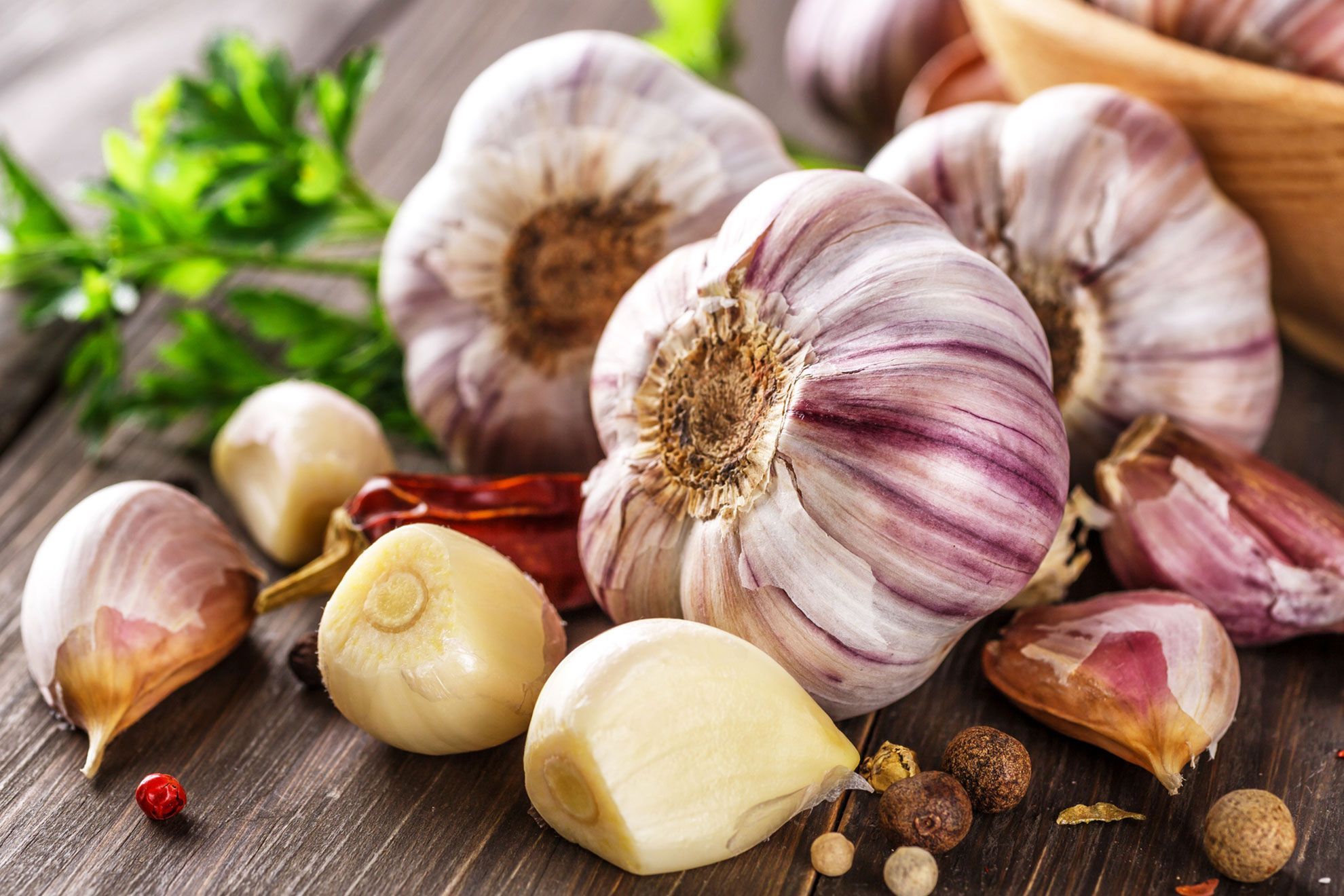Content
Making healthy choices among the vast variety of foods can be challenging, especially for people living with diabetes. Looking for effective and natural ways to manage diabetes, one of the key elements in the world of functional foods is garlic. In addition to its culinary qualities, garlic contains a powerful compound called allicin, which is essential for health, especially for those struggling with diabetes.
How does garlic lower blood sugar in diabetics?
Garlic’s ability to lower blood sugar in people with diabetes stems from its complex effects on physiological processes in the body. Allicin, the active component responsible for many of garlic’s therapeutic effects, plays a key role in this function.
Research shows that allicin increases the sensitivity of cells to insulin, which helps them absorb glucose more efficiently. Also, allicin can inhibit enzymes responsible for carbohydrate metabolism, slowing the breakdown of complex sugars into glucose and reducing the rise in blood sugar after a meal. Additionally, the sulfur-containing compounds in garlic contribute to its antioxidant properties. They help reduce oxidative stress common in diabetes.
By affecting these diverse aspects of glucose metabolism and oxidative stress, garlic has established itself as a natural regulator of blood sugar levels in people suffering from diabetes.
Is garlic good for type 1 and type 2 diabetes?
Garlic can be beneficial for both type 1 and type 2 diabetes. In the context of functional medicine, which focuses on finding the root causes of health problems, garlic is a powerful therapeutic agent.
In people with type 1 diabetes, the immune system attacks the cells that produce insulin. Garlic can play an important role in this regard by helping to strengthen immune function. Animal experiments have shown that compounds in garlic have anti-inflammatory properties that can reduce chronic inflammation common in autoimmune diseases such as type 1 diabetes. This anti-inflammatory effect can help maintain a balanced immune response and provide more effective management of the condition.
In people with type 2 diabetes, who often suffer from insulin resistance and impaired glucose metabolism, garlic may be useful as a means of improving the cellular response to insulin. This can help regulate blood sugar levels. In addition, garlic supports the cardiovascular system by maintaining cholesterol levels and blood vessel function. This is important because people with diabetes have an increased risk of cardiovascular disease.
As part of a general approach to a healthy lifestyle, including garlic in the diet can be a key factor in promoting optimal health for people who suffer from type 1 and type 2 diabetes.
Health benefits
Garlic offers numerous health benefits thanks to the compound allicin. Allicin is formed when raw garlic is crushed or chopped and is responsible for its characteristic aroma and taste. Scientific research has long explored the potential health benefits of allicin.
- Regulating blood sugar levels: Diabetes is often characterized by hyperglycemia – elevated blood sugar levels that are difficult to regulate. Allicin can help improve the insulin sensitivity of cells, making it easier for them to absorb glucose more efficiently. This may contribute to better blood sugar management in people with diabetes.
- Antioxidant protection: Oxidative stress is a common condition in diabetes. An imbalance between free radicals and antioxidants can cause cell damage. Allicin acts as a powerful antioxidant that helps reduce oxidative damage in people with diabetes.
- Cardiovascular support: People with diabetes are at increased risk of cardiovascular complications. Allicin may help support heart health by promoting optimal cholesterol levels and blood vessel function. Research shows that allicin may improve cardiovascular protection through its vasodilator and lipid-lowering effects.
- Improved glycemic control: Garlic has been studied for its potential to regulate glycemic response. Ingredients like Allyl Propyl Disulphide can improve insulin secretion and help regulate blood sugar levels.
- Reducing insulin resistance: Insulin resistance is a common problem in diabetes and makes it difficult for cells to use insulin effectively. Garlic can help address this problem by improving cellular sensitivity to insulin.
- Blood pressure management: Hypertension often accompanies diabetes and can increase the risk of cardiovascular problems. Garlic is known for its ability to support healthy blood pressure, which further supports cardiovascular health.
Garlic as part of an integrative diabetes treatment plan
Including garlic in an integrative diabetes treatment plan is a prospect that can offer numerous health benefits. An appropriate way to incorporate garlic into your treatment plan includes:
- Awareness: Before you start taking garlic as part of your diabetes treatment, it’s important to learn about its potential benefits and potential risks. This includes consulting with medical professionals and having a well-informed conversation about appropriate dosages and interactions with existing medications.
- Customization: The approach to using garlic should be customized to the patient’s individual needs and health profile. Some people may benefit more from garlic than others due to differences in their health conditions.
- Responsibility: Taking garlic should be done responsibly and in accordance with the instructions of a medical professional. It is necessary to observe the recommended doses and to monitor possible side effects or interactions with other drugs.
Resources:
- Bayan, L., Koulivand, PH, & Gorji, A. (2014). Garlic: a review of potential therapeutic effects. Avicenna Journal of Phytomedicine, 4(1), 1–14. https://www.ncbi.nlm.nih.gov/pmc/articles/PMC4103721/
- Centers for Disease Control and Prevention. (2022, June 20). Diabetes and Your Heart. Centers for Disease Control and Prevention. https://www.cdc.gov/diabetes/library/features/diabetes-and-heart.html
- Cloyd, Dr. J. (2023a, April 10). A Functional Medicine Hypertension Protocol. Rupa Health. https://www.rupahealth.com/post/functional-medicine-hypertension-protocol
- Cloyd, Dr. J. (2023b, July 5). Integrative Approaches to Managing High Blood Sugar: Specialty Testing, Lifestyle Modifications, and Natural Remedies. Rupa Health. https://www.rupahealth.com/post/integrative-approaches-to-managing-high-blood-sugar-testing-lifestyle-modifications-and-natural-remedies
- Cloyd, Dr. J. (2023c, November 2). The Top 5 Therapeutic Uses of Garlic: From the Kitchen to the Medicine Cabinet. Rupa Health. https://www.rupahealth.com/post/the-top-5-therapeutic-uses-of-garlic-from-the-kitchen-to-the-medicine-cabinet
- Cox, Dr. A. (2022, September 8). 4 Herbs And Supplements That May Help Control Type 1 Diabetes. Rupa Health. https://www.rupahealth.com/post/a-root-cause-approach-to-managing-type-1-diabetes
- Hou, L.-Q., Liu, Y.-H., & Zhang, Y.-Y. (2015). Garlic intake lowers fasting blood glucose: meta-analysis of randomized controlled trials. Asia Pac J Clin Nutr, 24(4), 575–582. https://doi.org/10.6133/apjcn.2015.24.4.15
- Qian, R., Chen, H., Lin, H., Jiang, Y., He, P., Ding, Y., Wu, H., Peng, Y., Wang, L., Chen, C., Wang, D., Ji, W., Guo, X., & Shan, X. (2023). The protective roles of allicin on type 1 diabetes mellitus through AMPK/mTOR mediated autophagy pathway. Frontiers in Pharmacology, 14, 1108730. https://doi.org/10.3389/fphar.2023.1108730

